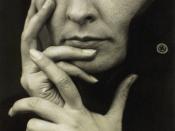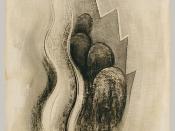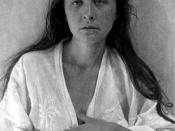I made this essay using art biographies on WWW Good Report
Twentieth-century art is almost indefinable, and ironically we can consider that as its definition. This makes sense, as we live in a world that is in a constantly changing. Not only is science changing the outward forms of life, but we are beginning to discover the strange centrality of our subconscious desires and fears. All this is completely new and unsettling, and art naturally reflects it. With so many interesting artists, some of whom time may justify as of great importance, there is only space to touch briefly on those who seem to many observers to be part of the story, and not just footnotes. Two artists who are not considered footnotes are Edward Hopper and Georgia O'Keeffe. Thomas Eakins and Winslow Homer may have influenced the course of future art in the United States during the twenties and thirties, but Edward Hopper and Georgia O'Keeffe emerged as the inspirational new painters of distinct American traditions.
Hopper's work was strongly realist, his still, precise images of gloom and loneliness reflected the social mood of the times. O'Keeffe's art was more abstract, often based on enlarged plants and flowers, and infused with a kind of surrealism she referred to as "magical realism." She may not have been a great painter, but her art was highly influential.
Edward Hopper was born in 1882 and died in New York in 1967. He worked as an illustrator, yet Hopper preferred not to paint people. This is perhaps why his cityscapes are so evocative, lacking of people and filled with the emptiness of night, of shadow, of solitude. "Maybe I am not very human," he once said. "What I wanted to do was to paint sunlight on the side of a house."
Hopper loved ships as a boy and spent his summers painting seascapes in New England, particularly after building a summer home on Cape Cod.
Whatever the motif -- seascape or urban, Paris or New York -- Hopper said in 1933, "My aim in painting has always been the most exact transcription possible of my most intimate impression of nature. If this end is unattainable, so, it can be said, is perfection in any other ideal of painting or in any other of men's activities."
O'Keeffe was born in the northern-central United States in 1887 and died in 1986. O'Keeffe found most of her subjects from nature during her long and fruitful career.
She studied at the Art Institute of Chicago and the Art Students League in New York. In 1915 O'Keeffe made her first consciously original works. After these were seen by Alfred Stieglitz, he arranged a one-woman exhibition in 1917. She married Stieglitz in 1924.
Among O'Keeffe's most famed work are probably her large, close-up representations of flowers.
O'Keeffe's familiarity with the American Southwest -- from her first visit in 1929 to her purchase of a home in 1945 -- provided her with ample imagery, including the Southwest landscape, animal bones and her adobe home. Among her finest works of this period is the Pelvis Series of 1943, juxtaposing animal bones against rugged backgrounds.
Another artist of the American twenties and thirties is Grant Wood. Grant wood began his artistic career as a social satirist but during the thirties he started to commemorate what he had earlier ridiculed. Wood's painting American Gothic (1930) was meant as a mockery but the American public took it as "the embodiment of American virtue and self-reliance." Wood seemed to change his feelings toward the painting after the public's reaction and "gradually abandoned the social satire of his earlier painting to glorify, in archaic stylization."
Art in the twenties and thirties held many new motifs and many different artists. American artists from the twenties and thirties can truly be called pioneers. They started a whole new revolution into the modern art era.


